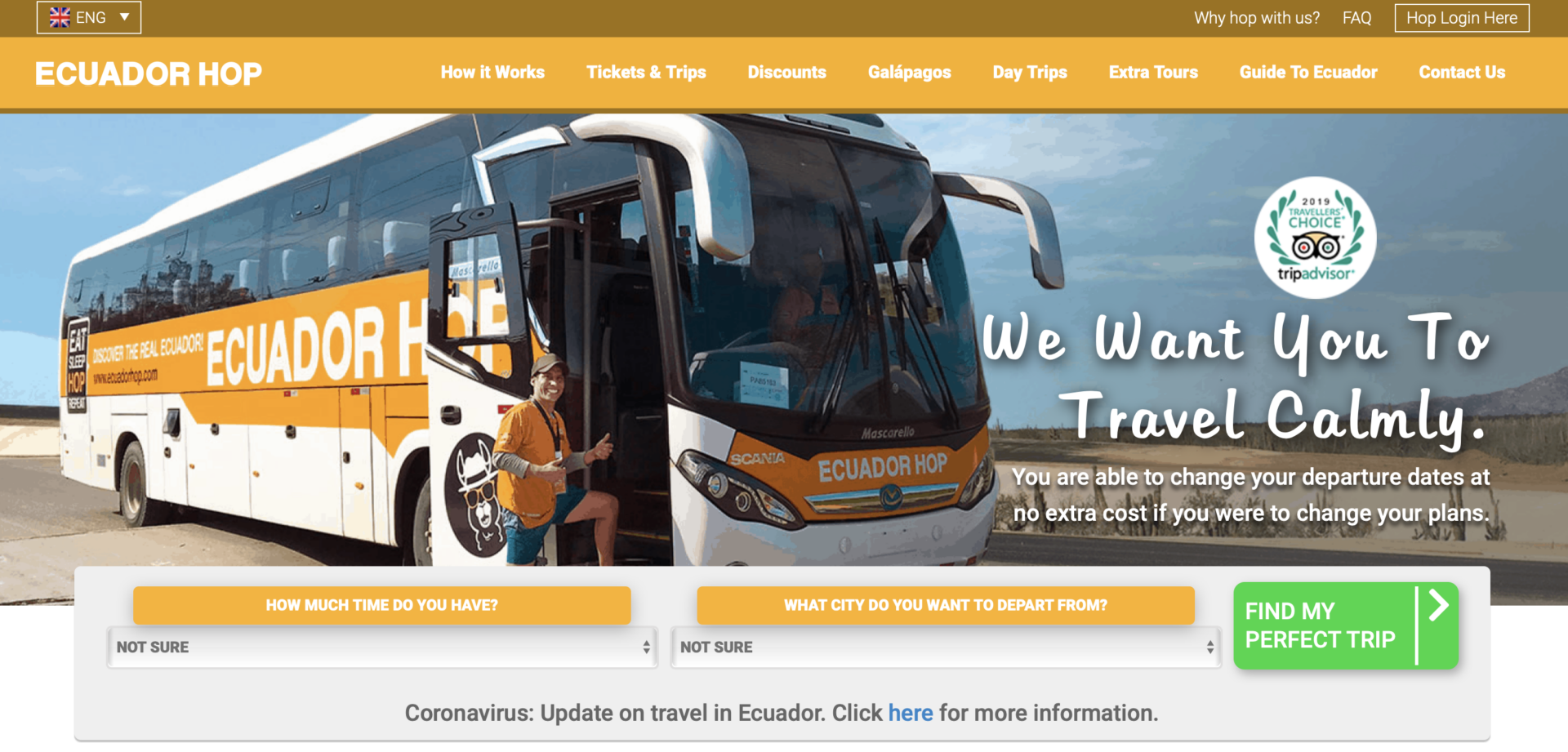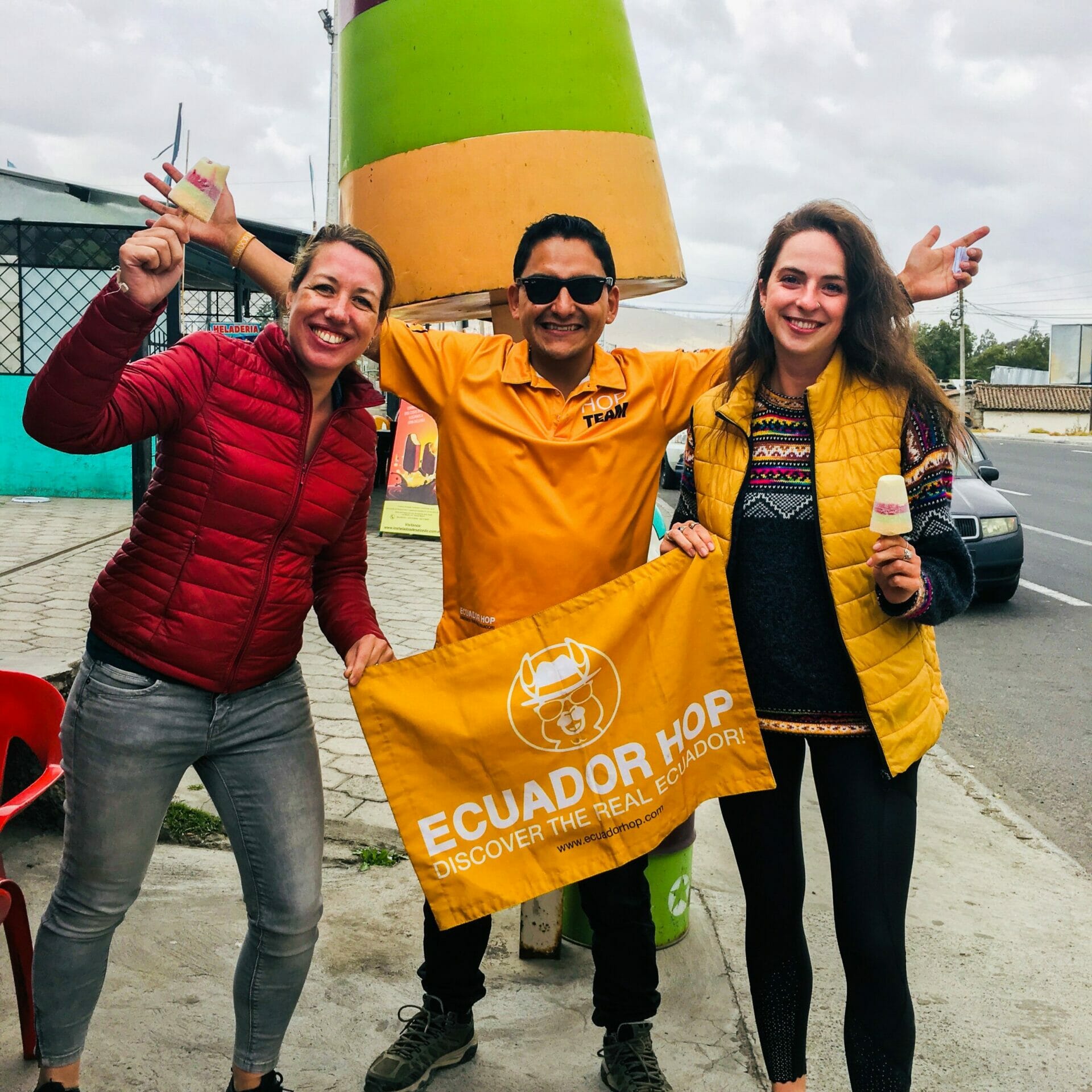
Last Updated on 5 June 2022
For all of South America, but particularly for an incredibly compact country like Ecuador, there is no better way to travel around than by bus— the scenery is beautiful, buses operate to every possible destination multiple times a day, and tickets are amazingly inexpensive. But how does travelling by public bus compare to a hop-on/hop-off service like Ecuador Hop, and which is actually the best way to explore Ecuador?
After travelling on public buses around the country, I partnered with Ecuador Hop (the same company that owns Peru Hop, which I’ve collaborated with previously) to review their new route from Quito to Montañita. This handy guide includes absolutely everything you need to know in order to decide whether public buses or Ecuador Hop makes the most sense for your trip.
Ecuador Hop generously provided me with a pass in exchange for a review of their service, but all opinions expressed within this post, good or bad, are entirely my own.
Ecuador Hop
What is Ecuador Hop?
Following the success of Peru Hop, an awesome hop-on/hop-off bus service connecting popular tourist destinations from Lima to Cusco, the same company created Ecuador Hop to offer a similar experience in Ecuador— rather than taking a taxi to the station and catching a public bus to your destination, Ecuador Hop can meet you directly at your hostel and get you from city to city with heaps of interesting stops along the way.
Ecuador Hop is the definition of slow travel. It’s not just about getting from Point A to Point B, but about all the incredible things you can see and all the awesome people you can meet along the way.
How does Ecuador Hop work?
Unlike a typical bus company where you purchase a single ticket to one destination, you purchase a pass with Ecuador Hop that includes stops at a number of popular destinations between Quito and Montañita, some of which are not directly connected by public bus. For example, you can ride from Quito to Baños, stopping off for a few hours at Laguna Quilotoa and Volcán Cotopaxi along the way, OR choose to “hop off” and spend a few days hiking the Quilotoa Loop or exploring Cotopaxi National Park.
There are a couple of local guides on board who can help you book tours and hostels at discounted rates or even just provide awesome recommendations on where to go once you get off the bus. Ecuador Hop isn’t a tour, though— you have complete freedom to build your own itinerary around their stops, hopping off and staying a couple days if you see something you like and then getting back on the bus when you’re ready to keep travelling.
Public buses
What are public buses in Ecuador like?
Compared to long distance bus travel in other Latin American countries, like the 24hr bus ride from Lima to Cusco or the long haul from Santiago to Buenos Aires, there really is no such thing as “long distance” in Ecuador. So, even though the buses in Ecuador aren’t quite as luxurious as those you’ll find in Peru, Chile, or Argentina, they are perfectly comfortable for the reasonably small amount of time you’re actually on board.
The buses in Ecuador don’t usually have a toilet on board or offer the super comfy semi-cama seats that recline nearly horizontal, but they do make up for it by being incredibly inexpensive. The general rule is that you’ll pay just $1USD per hour of bus travel, which makes Ecuador one of the cheapest countries in Latin America in terms of transport costs.
Just like on a plane, you can carry a smaller bag onto the bus and store your big backpack underneath (you’ll have a ticket that corresponds to your bag so you can collect it later, just make SURE you see your bag put onto the bus). Unfortunately, buses in Ecuador do have a bit of a reputation, so it’s incredibly important that you keep your “carry on” bag with all your valuables either at your feet or, ideally, on your lap rather than in the overhead bins or on the seat next to you (if you’re planning to sleep). I never experienced it myself, but I know theft does happen on buses in Ecuador, so you do need to be extra cautious when travelling.
How do I buy bus tickets in Ecuador?
Bus terminals in Ecuador range from small regional stations with only a few operators, like in Baños, to enormous airport-sized stations with multiple levels and sections, like Quito’s Terminal Quitumbe. Either way, there will be ticket booths for each bus company lining the perimeter of the station, with bright signs advertising their destinations or vendors shouting out places like “Guayaquil, Guayaqil!“. Companies servicing a particular region tend to be grouped together, so you can visit a few neighbouring windows to compare prices if you’re on a tight budget.
Also keep in mind that you’ll be asked for your passport when you purchase bus tickets, so have it handy!
It really is incredibly simple to rock up to a bus station in Ecuador and purchase tickets to anywhere you want to go (no need to purchase tickets online in advance), but this is also somewhat dependent on your level of Spanish— do not expect anyone at the bus station to speak a word of English.
Here are the most essential phrases to know:
- Yo necesito comprar un boleto a [your destination] | I need to buy a bus ticket to [your destination]
- A qué hora es el próximo bus? | What time is the next bus?
- A qué hora el bus llegas en [your destination]? | What time does the bus arrive in [your destination]?
- Cuánto cuesta? | How much does it cost?
- Es posible pagar con una tarjeta? | Is it possible to pay with a credit card?
- El bus tiene un baño? | Does the bus have a toilet?
- De donde sale el bus? | Where does the bus depart from? (they’ll usually give you a number corresponding to the parking spot or boarding door)

Laguna Quilotoa
An honest review of Ecuador Hop
Cost of travel
Even though Ecuador Hop’s passes are reasonably priced for what you get, they are still FAR more expensive than taking public buses along the same route. You could certainly justify this added expense since it saves heaps of transit time and crams in so many awesome destinations, but it probably won’t appeal to those travelling on a shoe-string budget.
To compare:
- Quito to Montañita with Ecuador Hop $159USD
VS
- Public buses between Quito and Montañita ~ $27USD total
- Quito to Cotopaxi (bus to Latacunga and then hop off near the National Park, might have to hitchhike to the entrance) $2USD
- Cotopaxi to Quilotoa (transfer through Latacunga or Sigchos) $3USD
- Quilotoa to Baños (transfer through Latacunga and Ambato) $3USD
- Baños to Riobamba $2USD
- Riobamba to Alausí $2USD
- Alausí to Cuenca $5USD
- Cuenca to Guayaquil $5USD
- Guayaqil to Montañita $5USD
You’ll also need to consider the cost of taking a taxi or an Uber to and from the bus terminal in many of these cities (which can easily be $15USD in Quito), but even so, Ecuador Hop is exponentially more expensive than travelling by bus. If stretching your funds is your absolute top priority, public buses are a better option for you.
The most cost-effective option: public buses
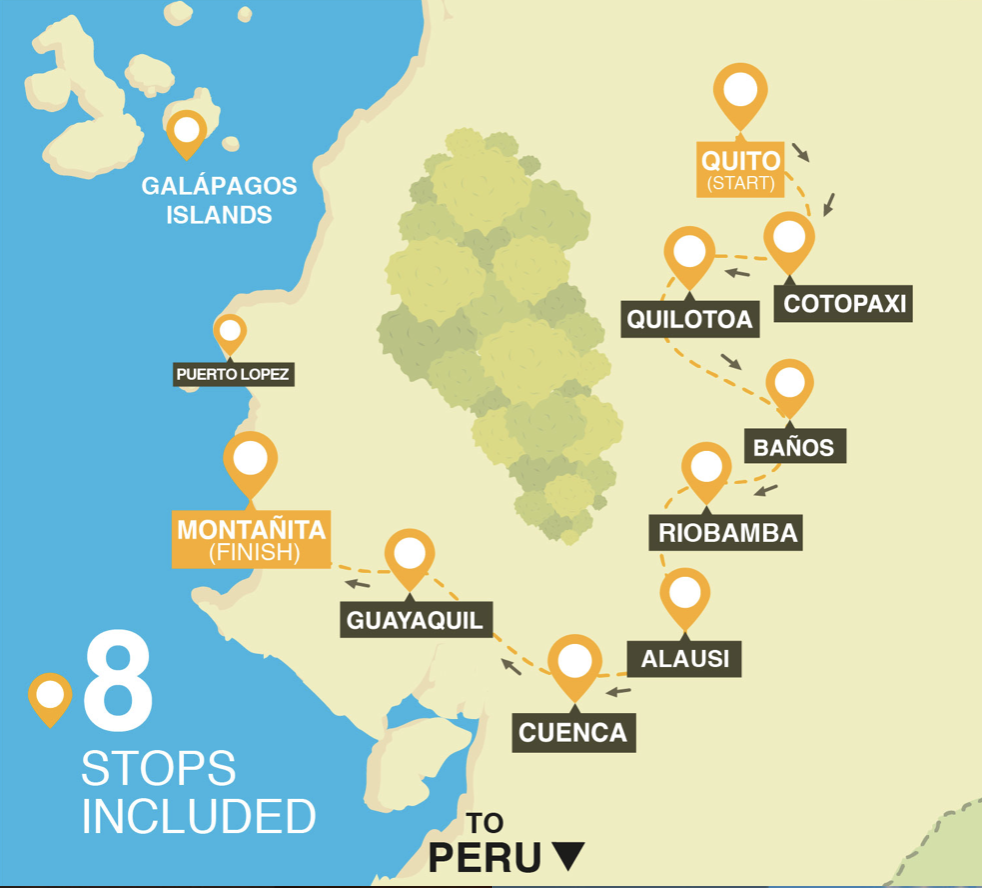
Convenience
Instead of having to get yourself to the bus terminal (which is sometimes way out of town or really far from the national park entrance), the Ecuador Hop bus will drop you off and pick you up directly at your hostel or a specific point of interest (in the case of Cotopaxi National Park and Laguna Quilotoa).
Transporting my heavy backpack and all of my valuables through a busy bus terminal in a shady part of town by myself probably tops the list in terms of travel stress, and I’m certainly not a fan of multiple bus transfers either, so it was pretty nice to completely eliminate this and just get straight to exploring a new place. If you are looking to minimise stress on your trip, Ecuador Hop is definitely the best choice.
The most convenient option: Ecuador Hop
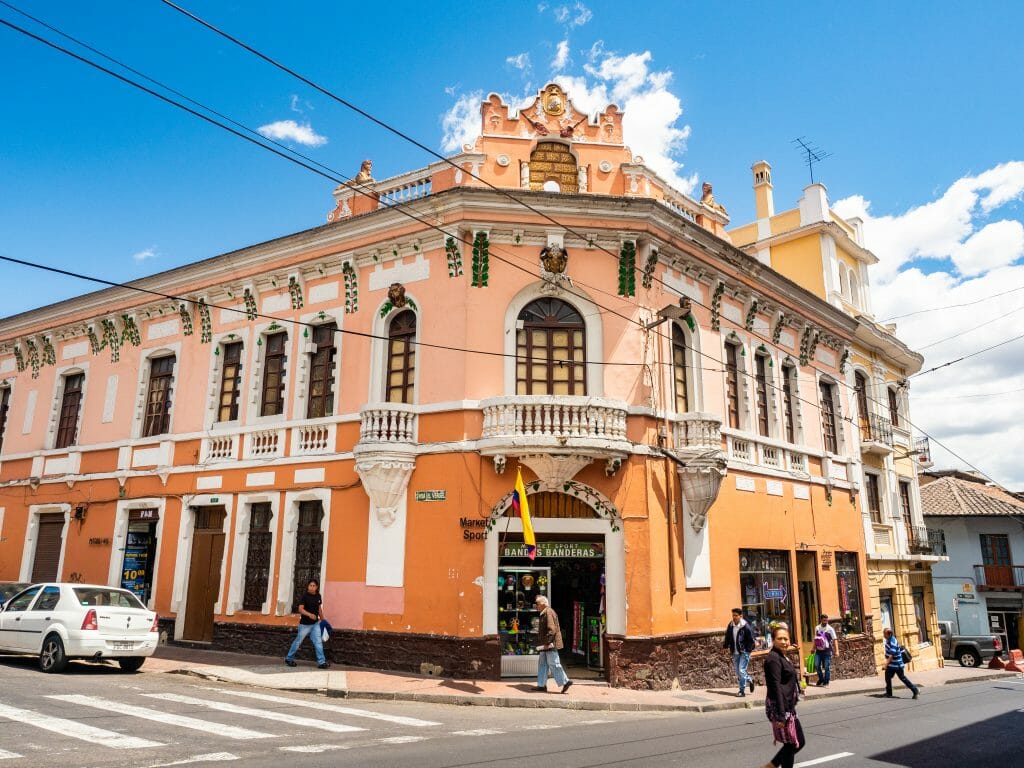
Safety
Although Ecuador is overall a very safe country for travellers (even as a solo female), theft is still a possibility, with the highest amount of petty crime seemingly concentrated around bus stations or even on the bus itself. Countless people warned me to be especially cautious of my valuables while on public buses in Ecuador, as there are a number of known scams related to people “moving” your backpack under the bus (or just the classic technique of stealing your stuff while you sleep).
I didn’t experience anything like this myself in Ecuador (PHEW), but I was certainly wary of it, so naturally I was more relaxed when travelling with Ecuador Hop, knowing my bags and all my belongings were totally safe, even if I got off the bus to eat or use the bathroom at a stop. I don’t say this to scare anyone away from taking public buses, just know that you WILL need to be a lot more vigilant of your valuables.
The safest option: Ecuador Hop
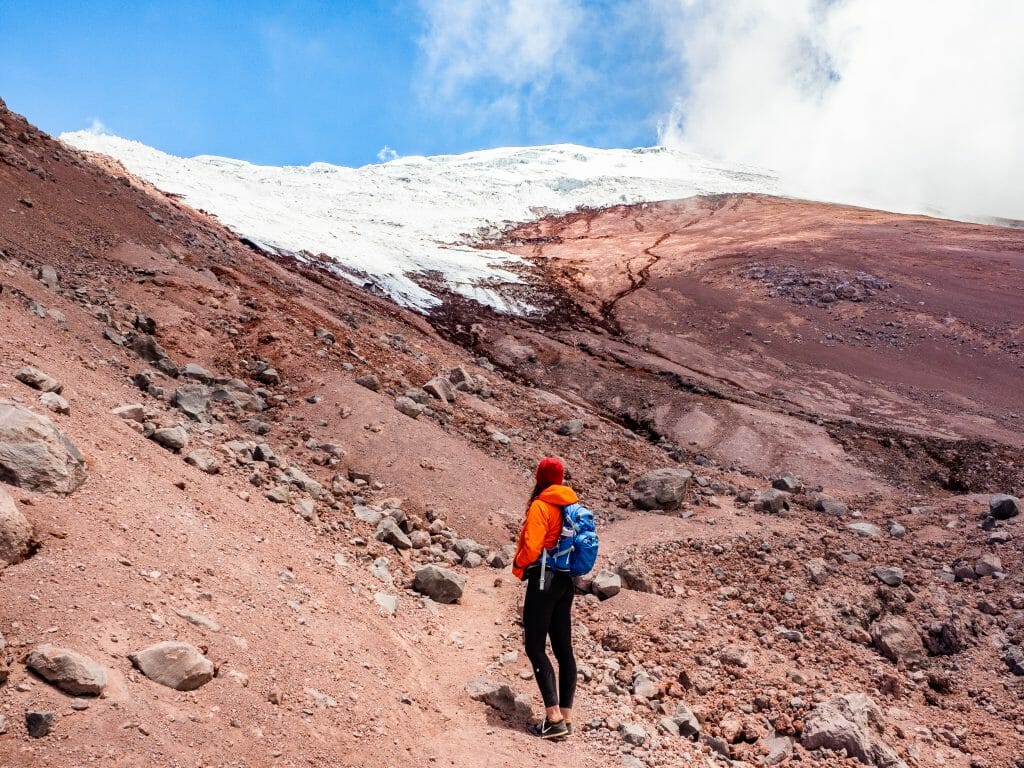
Comfort
Compared to the large, new buses used by Peru Hop, some of which are even double-decker with a toilet on board, the Ecuador Hop buses I travelled on were a bit of a surprise. Not necessarily in a bad way, I just wasn’t expecting a mini-bus, especially considering that all the photos on their website show large, new buses like those used by Peru Hop or by public bus companies.
It’s possible this will change as more travellers use Ecuador Hop and larger numbers require larger buses, but even so, the only real limitation of travelling in the small mini-bus was that there wasn’t an option to recline. The sacrifice in comfort is relatively minimal, but public buses are probably a bit nicer in terms of the seats.
The most comfortable option: public buses
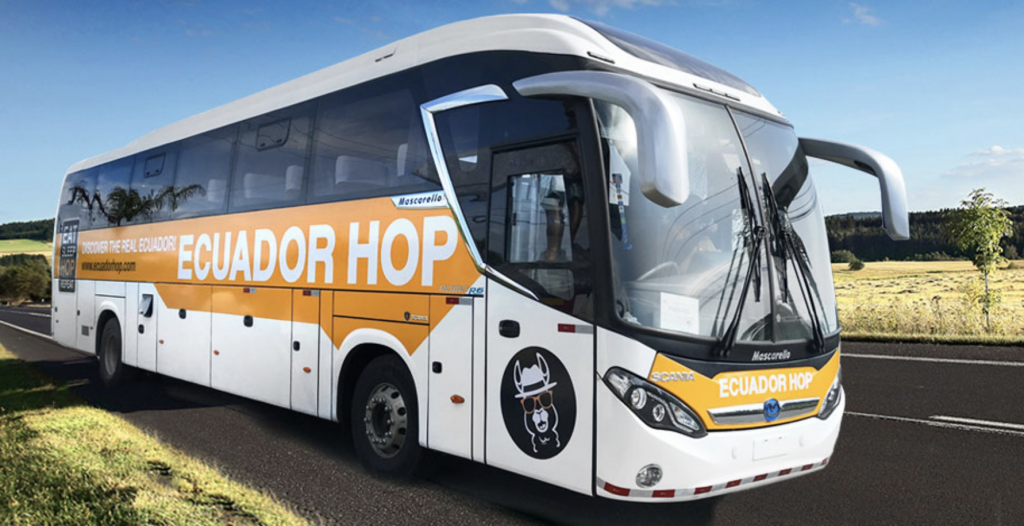
Route
One of the things I loved about Ecuador Hop was being transported directly to all the best places like Cotopaxi National Park and Laguna Quilotoa that aren’t serviced by a direct public bus. This means less time in a taxi or waiting at a bus terminal and more time actually enjoying yourself, which is a huge bonus for those trying to cram as much as possible into their trip.
However, it’s definitely important to note that Ecuador Hop can’t take you everywhere. There are some absolutely amazing places around the country, like Ayangue, Papallacta, or Otavalo, that simply aren’t part of the route, which means you will need to take a public bus to visit a lot of these destinations.
Plus, public buses are running pretty much constantly throughout the day to various destinations, so you have heaps of options for when you want to leave compared to the single (or even every-second-day) departures for Ecuador Hop. Actually, I ended up having to take a public bus from Baños to Guayaquil since I didn’t want to wait an extra day for the Ecuador Hop bus, so you definitely compromise some flexibility when you’re travelling exclusively with Ecuador Hop.
The best way to maximise your time: Ecuador Hop
The most flexible option: public buses

Social
Without a doubt, one of the best things about Ecuador Hop was the community vibe on board the bus. A lot of people are travelling at a similar speed through the country and stopping in all the same place, so you can easily make friends and see a lot of these people on the bus over the course of your journey.
As a solo female traveller, I loved how easy it was to meet people and I ended up having dinner or exploring with some of these friends even after we’d finished the Ecuador Hop portion of our trips. Considering that a majority of people on public buses are locals, and even other travellers are on a million different schedules, it would be a lot more difficult to make friends on a public bus (though not impossible!).
The most social option: Ecuador Hop
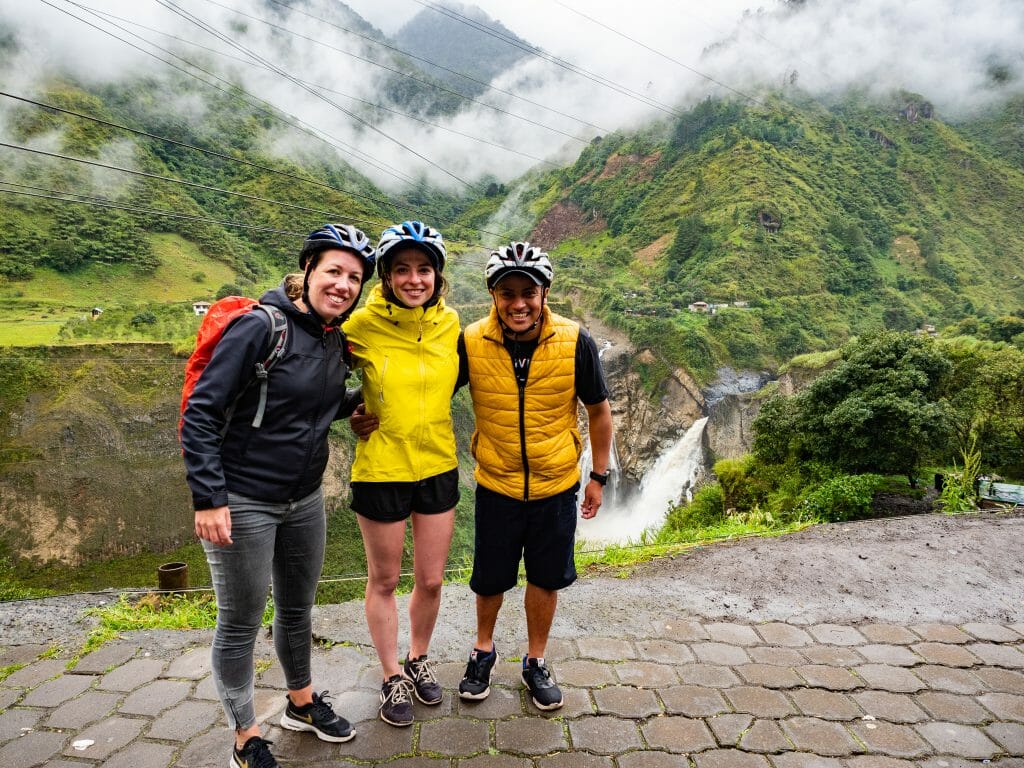
So…Ecuador Hop or public bus?
Ecuador Hop is best for:
- Travellers whose time is at a higher premium than their money: I find that every trip I take is a constant balance between the time I have and the budget I’m trying to stick to— if you have nothing but time, you could take a taxi from Quito to Terminal Quitumbe, then a public bus to Latacunga, hop off the road near Cotopaxi, and hitchhike to the entrance of the National Park. BUT if you don’t have heaps of time and you’re trying to fit a lot in, you could pay more to travel directly from your hostel in Quito to Cotopaxi National Park with Ecuador Hop, maximising time to explore.
- Solo or first-time travellers who are willing to sacrifice a little flexibility for safety and convenience: If you’re a bit wary about getting to the bus terminal on your own or buying a bus ticket with limited Spanish, Ecuador Hop completely eliminates that stress.
- Solo travellers (or couples) who want to meet other travellers: Ecuador Hop is an incredibly easy way to make friends and socialise with other people, all without having to actually join a tour and compromise your independence.
Public buses are best for:
- Travellers on a shoe-string budget: If your money is more valuable than your time, public buses are WILDLY less expensive and will help you stretch your funds farther on a big trip around Ecuador/Latin America.
- Travellers who want maximum flexibility: There are so many bus companies in Ecuador operating myriad routes throughout the day and night, so opting to travel by public bus will give you the greatest amount of flexibility to design your own itinerary and travel whenever you want.
- Travellers who want to visit destinations not included with Ecuador Hop: If you want to visit other amazing places like Ayangue, Papallacta, or Otavalo, public buses can take you to hundreds of destinations around Ecuador that aren’t yet part of the Ecuador Hop route.
Read more about Ecuador
ABSOLUTELY EVERYTHING YOU NEED TO KNOW ABOUT A LAND-BASED TRIP TO THE GALÁPAGOS (WITHOUT A CRUISE)
GALÁPAGOS PACKING LIST: WHAT TO PACK FOR A LAND-BASED TRIP
THE BEST PLACE TO SCUBA DIVE WITH MANTA RAY IN ECUADOR: BAJO COPE, AYANGUE
WHAT TO DO IN QUITO: 12 AWESOME THINGS TO DO IN ECUADOR’S CAPITAL
RUTA DE LAS CASCADAS: BIKING THE WATERFALL ROUTE IN BAÑOS, ECUADOR
9 AMAZING THINGS TO DO IN BAÑOS: A GUIDE TO ECUADOR’S ADVENTURE CAPITAL
THE PERFECT 2-3 WEEK GALÁPAGOS & MAINLAND ECUADOR TRAVEL ITINERARY

